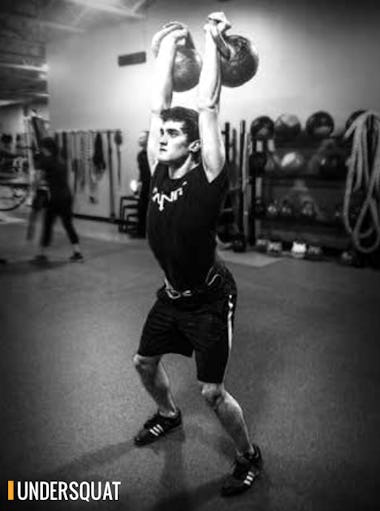The Kettlebell Jerk is an excellent full body exercise that requires a high degree of coordination, timing, and the ability to generate maximum power in a short range of motion. Although it can be used for developing maximal strength, this movement is best suited for “work capacity,” or the ability to be strong, fast, and explosive over longer durations.
Along with the Long Cycle (also called Clean & Jerk) and Snatch, the Jerk is one of the primary events in Kettlebell Sport competition. It is most commonly coupled with the Snatch in the Biathlon event. In competition, athletes lift for five or ten minute sets for as many reps as possible with technical proficiency without putting the kdettlebells down.
Kettlebell Jerk Technique
The Jerk Has 5 Primary Technique Components:
1. Half Squat
2. Bump
3. Undersquat
4. Stand to Lockout/Fixation
5. Drop to Rack Position
Rack
Ideally, the elbows are resting directly on the hips (iliac crests), knees are locked, pelvis is forward, torso deflected back, and the thoracic spine is curved. However, nuances of an individuals rack position will differ depending on body type. The primary goal is rest and connection between arms/torso.
Half Squat
While keeping the pelvis forward, drop into a shallow knee bend. Two important points here are to first, “drop/fall” into the Half Squat to activate a stretch reflex instead of descending slowly. Second, maintain connectivity between the elbows to torso and heels to ground. This maximizes power transfer from the lower body to the upper body and arms.
Bump
This involves what is termed a “quadruple extension.” The ankles, knees, hips, and torso all extend during this movement. The final position involves the hips being up/ forward and the shoulders being down/back. The degree of energy a competitor puts into this part of the movement is dependent on their body type, athletic attributes, etc.
Undersquat
To maximize efficiency, the arms are locked by dropping down into a squatting posture instead of pressing up. The depth of the Undersquat is dependent on the person’s anatomy and conditioning. Those with strong legs and elbow extensors may drop deeper. Lighter competitors, whose primary advantage is speed, may tend to use a shallow Undersquat. The key is to pick a movement strategy that conserves energy and keeps the heart rate low. This allows for more repetitions and longer duration.
Stand to Lockout
There are two primary movement mechanics to accomplish this. First, simply stand up to the overhead posture. Second, the competitor can use a “knee roll” which involves keeping the hips at the level of the Undersquat and only rolling the knees backward to lockout. Thus, there is no true level change which is less work and more efficient. In addition, the anterior pelvic tilt this mechanic creates relaxes the quadriceps. Again, this conserves energy which equals better performance.
Drop to the Rack Position
The triceps are turned “off” and the bells are lowered to the rack position via a controlled drop. The force of the bells coming down is absorbed by raising up on the heels and bringing the chest toward the bells. As the elbows begin to land in the rack position, the heels are lowered and the thoracic spine rounded to safely diffuse the load. The knees may be bent slightly as well. The key is timing the bell to body contact with the shock absorption mechanics.
Breathing
Exhale during the Half Squat, inhale on the bump, exhale upon landing into the Undersquat/stand to lockout, additional breathing cycle in the top position, inhale at the beginning of the drop, exhale as the elbows make contact into the rack. From there, most competitors will take recovery breaths in the rack. If a deep Undersquat is used, then exhale upon landing into the Undersquat, inhale during the stand to lockout; perform an additional breathing cycle in the top position, inhale at the beginning of the drop, and finally exhale as the elbows make contact into the rack. Some competitors will also use lockout/fixated position for recovery breathing.
Common Errors
1. Lack of connection between the elbow/hips and the heel/floor when descending into the Half Squat.
2. Descending too slowly when dropping into the Half Squat which negates the desired stretch reflex.
3. Pressing to lockout instead of dropping to the Undersquat to lock the arms.
4. “Posing” – slow transition from the Undersquat to lockout which fatigues legs and arms.
5. Not relaxing enough and being too tense, which decreases efficiency, increases heart rate, and decreases performance.







)





